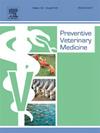Spatiotemporal patterns and risk factors for African swine fever-affected smallholder pig farms in Davao Region, Southern Philippines
IF 2.2
2区 农林科学
Q1 VETERINARY SCIENCES
引用次数: 0
Abstract
African swine fever (ASF) has severely disrupted the Philippine pig industry, necessitating a thorough understanding of its local epidemiology to develop effective mitigation strategies. The outbreak has particularly impacted smallholder farmers, who face substantial economic losses, livelihood threats, and psychological distress due to ASF. This study examined the ASF outbreak in Davao Region, Southern Philippines, by analyzing its spatiotemporal patterns and identifying risk factors. The investigation involved three parts: determining spatiotemporal patterns using spatial autocorrelation and hotspot analysis, conducting Key Informant Interviews (KIIs) with government veterinarians to identify local risk factors, and fitting a conditional logistic regression model to estimate the effects of biosecurity and farming practices on the likelihood of ASF occurrence. A sharp decline in incidence rates and non-recurring hotspots of ASF-affected barangays (villages) were observed, which may have been influenced by community quarantines and 1–7–10 zoning protocols. However, ASF hotspots continuously shifted towards the northeast provinces of the region. Thematic analysis of collected data from KIIs highlighted six general areas of ASF management and control that have posed challenges: farm biosecurity, traders' roles, farmers' capabilities, slaughterhouse practices, veterinary services, and response gaps. Regression analysis revealed that biosecurity measures for trade vehicles and cleaning practices were associated with a decreased likelihood of ASF risk, while swill feeding, inadequate waste management, and improper disposal of diseased pigs were associated with an increased likelihood of ASF risk. These findings provide critical insights for managing ASF spread while supporting smallholder farmers, strengthening the livestock industry’s resilience against similar diseases.
菲律宾南部达沃地区受非洲猪瘟影响的小型养猪场的时空格局和风险因素
非洲猪瘟(ASF)严重破坏了菲律宾的养猪业,因此必须彻底了解当地的流行病学,以制定有效的缓解战略。疫情对小农的影响尤其严重,他们因非洲猪瘟面临巨大的经济损失、生计威胁和心理困扰。本研究通过分析其时空格局和确定风险因素,对菲律宾南部达沃地区的非洲猪瘟疫情进行了调查。调查包括三个部分:利用空间自相关和热点分析确定时空格局;与政府兽医进行关键线人访谈(KIIs)以确定当地危险因素;拟合条件logistic回归模型以估计生物安全和耕作方式对非洲猪瘟发生可能性的影响。观察到受非洲猪瘟影响的村(村)发病率急剧下降和非重复热点,这可能受到社区隔离和1-7-10分区协议的影响。然而,非洲猪瘟热点不断向该地区东北省份转移。对从kii收集的数据进行的专题分析强调了非洲猪瘟管理和控制中构成挑战的六个一般领域:农场生物安全、贸易商的角色、农民的能力、屠宰场做法、兽医服务和应对差距。回归分析显示,贸易车辆的生物安全措施和清洁做法与非洲猪瘟风险的可能性降低有关,而泔水喂养、废物管理不足和病猪处置不当与非洲猪瘟风险的可能性增加有关。这些发现为管理非洲猪瘟传播提供了重要见解,同时支持小农,加强畜牧业对类似疾病的抵御能力。
本文章由计算机程序翻译,如有差异,请以英文原文为准。
求助全文
约1分钟内获得全文
求助全文
来源期刊

Preventive veterinary medicine
农林科学-兽医学
CiteScore
5.60
自引率
7.70%
发文量
184
审稿时长
3 months
期刊介绍:
Preventive Veterinary Medicine is one of the leading international resources for scientific reports on animal health programs and preventive veterinary medicine. The journal follows the guidelines for standardizing and strengthening the reporting of biomedical research which are available from the CONSORT, MOOSE, PRISMA, REFLECT, STARD, and STROBE statements. The journal focuses on:
Epidemiology of health events relevant to domestic and wild animals;
Economic impacts of epidemic and endemic animal and zoonotic diseases;
Latest methods and approaches in veterinary epidemiology;
Disease and infection control or eradication measures;
The "One Health" concept and the relationships between veterinary medicine, human health, animal-production systems, and the environment;
Development of new techniques in surveillance systems and diagnosis;
Evaluation and control of diseases in animal populations.
 求助内容:
求助内容: 应助结果提醒方式:
应助结果提醒方式:


